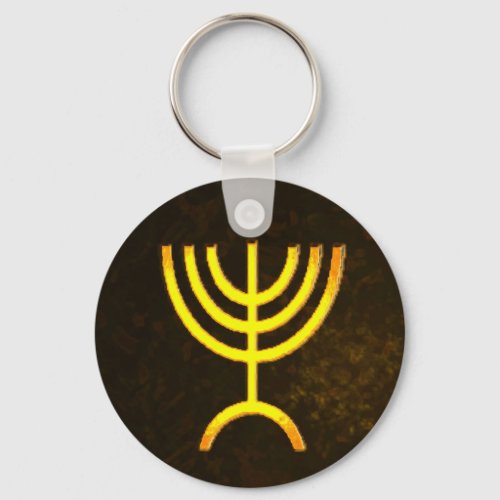Menorah Flame Keychain



A brown and gold digital rendering of the Jewish seven-branched menorah (Hebrew: ×žÖ°× ×•Ö¹×¨Ö¸×”â€Ž). The seven-branched menorah, used in the portable sanctuary set up by Moses in the wilderness and later in the Temple in Jerusalem, has been a symbol of Judaism since ancient times and is the emblem on the coat of arms of the modern state of Israel. The kohanim lit the menorah in the Sanctuary every evening and cleaned it out every morning, replacing the wicks and putting fresh olive oil into the cups. It has been said that the menorah is a symbol of the nation of Israel and our mission to be "a light unto the nations." (Isaiah 42:6). Our sages emphasize that light is not a violent force; Israel is to accomplish its mission by setting an example, not by using force. This idea is highlighted in the vision in Zechariah 4:1-6. Zechariah sees a menorah, and G-d explains: "Not by might, nor by power, but by My spirit." G-d revealed the design for the menorah to Moses as follows (Exodus 25:31-40): 31 And you must make a lampstand of pure gold. Of hammered work the lampstand is to be made. Its base, its branches, its cups, its knobs and its blossoms are to proceed out from it. 32 And six branches are running out from its sides, three branches of the lampstand from its one side and three branches of the lampstand from its other side. 33 Three cups shaped like flowers of almond are on the one set of branches, with knobs and blossoms alternating, and three cups shaped like flowers of almond on the other set of branches, with knobs and blossoms alternating. This is the way it is with the six branches running out from the lampstand. 34 And on the lampstand are four cups shaped like flowers of almond, with its knobs and its blossoms alternating. 35 And the knob under two branches is out of it and the knob under the two other branches is out of it and the knob under two more branches is out of it, for the six branches running out from the lampstand. 36 Their knobs and their branches are to proceed out from it. All of it is one piece of hammered work, of pure gold. 37 And you must make seven lamps for it; and the lamps must be lit up, and they must shine upon the area in front of it. 38 And its snuffers and its fire holders are of pure gold. 39 Of a talent of pure gold he should make it with all these utensils of it. 40 And see that you make them after their pern that was shown to you in the mountain. Until 2009, the earliest preserved representation of the menorah of the Temple was depicted in a frieze on the Arch of Titus, commemorating his triumphal parade in Rome following the destruction of Jerusalem in the year 70. In 2009, however, the ruins of a synagogue with pottery dating from before the destruction of the Second Temple were dised under land in Magdala owned by the Legionaries of Christ, who had intended to construct a center for women's studies. Inside that synagogue's ruins was discovered a rectangular stone, which had on its surface, among other ornate carvings, a depiction of the seven-branched menorah differing markedly from the depiction on the Arch of Titus, probably carved by an eyewitness to the actual menorah present at the time in the Temple at Jerusalem. This menorah has arms which are polygonal, not rounded, and the base is not graduated but triangular. Representations of the seven branched artifact have been found on tombs and monuments dating from the 1st century as a frequently used symbol of Judaism and the Jewish people. Contrary to some modern designs, the ancient menorah did not contain anything resembling seven candles as they did not exist then.


